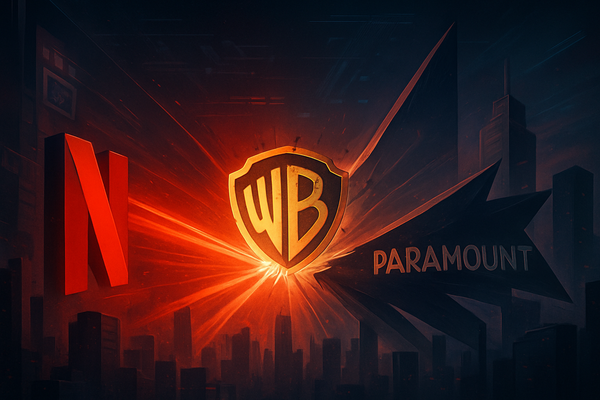zSpace: A Headset-Free Visionary Navigating the VR/AR Frontier Amidst Financial Headwinds

As of late 2025, zSpace, Inc. (NASDAQ: ZSPC) stands at a pivotal juncture in the rapidly evolving virtual and augmented reality (VR/AR) landscape. While often overshadowed by consumer-focused giants, zSpace has carved out a distinct and critical niche in immersive learning and workforce development with its innovative, headset-free technology. This unique approach, offering tactile and interactive 3D experiences on specialized displays, positions the company as a potential mover in redefining how VR/AR is deployed in institutional settings, even as it grapples with significant financial challenges.
The company's strategic focus on education and vocational training, coupled with recent expansions into high-demand areas like industrial robotics and health sciences, suggests a compelling, albeit high-risk, investment proposition for those eyeing the transformative potential of immersive technologies beyond mere entertainment. Investors are closely watching whether zSpace's technological differentiation and strategic pivot towards a software-centric model can overcome its current financial turbulence and unlock its potential to lead in the specialized B2B VR/AR market.
The Headset-Free Pioneer: ZSpace's Journey Through Immersive Learning
zSpace's journey has been defined by its commitment to an innovative, headset-free augmented and virtual reality experience, a stark contrast to the bulky head-mounted displays prevalent in much of the VR market. This core technological differentiator allows users, primarily students and trainees, to interact with holographic-like 3D content directly on specialized screens using head-tracking and an interactive stylus. This design choice aims to mitigate common barriers to VR adoption in educational environments, such as discomfort, hygiene concerns, and the logistical complexities of managing multiple headsets.
The company's strategic timeline leading up to late 2025 has seen several key developments. zSpace has established a significant footprint, serving over 2,400 U.S. school districts, technical centers, community colleges, and universities, impacting millions of learners. In January 2025, zSpace launched its Imagine AR/VR laptop, specifically tailored for elementary education with a simplified user experience. This was followed by the introduction of the "Career Explorer" app in June 2025, integrating AR/VR with an AI-driven "Career Coach" to guide students through various career paths. More recently, in September and October 2025, zSpace expanded its content library into critical areas such as industrial robotics applications, enhanced automotive training for electric and hybrid vehicles, and immersive health science applications for anatomy and ECG training, diversifying its market reach beyond traditional K-12 STEM.
Despite these technological advancements and market penetration, zSpace has faced considerable financial headwinds. In October 2025, the company received a Nasdaq non-compliance notice regarding its minimum market value requirements, necessitating a transfer of its listing to the Nasdaq Capital Market to maintain its stock exchange presence. The second quarter of 2025 revealed flat GAAP revenue year-over-year at $7.46 million, a significant 54% decline in bookings, widening net losses, and dwindling cash reserves. However, a glimmer of hope appeared in Q1 2025, with gross margins increasing to 47.4%, a 13-percentage-point jump attributed to a strategic shift towards software and services revenue and the introduction of more cost-efficient hardware. The annualized contract value of its renewable software also saw an 11% increase, signaling a potential shift towards a more sustainable business model. Key players involved include CEO Paul Kellenberger, who has been steering the company through these strategic shifts and financial challenges.
Ripple Effects: Winners and Losers in the Immersive Learning Ecosystem
The trajectory of zSpace (NASDAQ: ZSPC) holds significant implications for various players within the immersive learning and broader VR/AR ecosystems. Its unique approach could either validate a new paradigm for institutional VR/AR or underscore the dominance of headset-based solutions, thereby affecting competitors and partners alike.
Potential Winners:
- EdTech Software Developers: Should zSpace's platform gain further traction, third-party developers specializing in educational content and training simulations could find an expanding market for their applications tailored to zSpace's headset-free environment. This could lead to partnerships and licensing opportunities.
- Vocational Training Institutions & Corporate L&D: As zSpace expands its offerings in areas like industrial robotics, electric vehicle maintenance, and health sciences, institutions and corporations focused on skills development stand to benefit from more effective, engaging, and scalable training solutions. This could lead to increased adoption and improved learning outcomes.
- Hardware Component Suppliers: While zSpace manufactures its own specialized displays, a significant increase in demand for their products could indirectly benefit suppliers of high-resolution screens, head-tracking sensors, and haptic feedback components.
Potential Losers/Affected Parties:
- Traditional Headset-Based VR/AR Providers in EdTech: Companies that primarily offer headset-based VR/AR solutions for education and training might face increased competition from zSpace's differentiated model. If zSpace successfully demonstrates the superiority or cost-effectiveness of its headset-free approach for certain use cases, it could erode market share from those relying solely on head-mounted displays. While direct competitors like Meta Platforms (NASDAQ: META) and Apple (NASDAQ: AAPL) primarily target the consumer market, their enterprise solutions could still feel an indirect impact.
- Legacy EdTech Providers: Traditional educational technology companies offering 2D software or less immersive solutions could see increased pressure to innovate and incorporate more engaging, interactive experiences to compete with the efficacy offered by zSpace's platform.
- Companies with Limited Content Libraries: zSpace's continuous expansion of its proprietary software ecosystem and content library, particularly in high-demand vocational fields, means that companies with smaller or less diverse content offerings might struggle to keep pace with the breadth of learning experiences zSpace provides.
The financial health of zSpace itself remains a critical factor. Its ability to secure funding and stabilize its revenue will determine its capacity to be a "winner" in its own right and to truly influence the market dynamics. If it falters, it could open opportunities for other players to step in, potentially adopting similar headset-free concepts or reinforcing the current market trends.
Broader Significance: Redefining Immersive Experience Beyond the Headset
zSpace's (NASDAQ: ZSPC) trajectory is more than just the story of a single company; it represents a significant inflection point in the broader VR/AR industry, particularly concerning its application beyond consumer entertainment. The company's unwavering commitment to a headset-free immersive experience challenges the prevailing narrative that VR/AR inherently requires a head-mounted display. This approach fits into a wider industry trend of seeking more accessible, comfortable, and scalable immersive solutions for professional and educational environments.
The potential ripple effects on competitors and partners are considerable. If zSpace successfully navigates its financial challenges and expands its market reach, it could compel other immersive technology providers to explore alternative form factors and interaction methods. This could lead to a diversification of VR/AR hardware, moving beyond traditional headsets to include more desktop-based, collaborative, or even room-scale projection systems. For instance, companies like Dassault Systèmes (EPA: DSY) and Autodesk (NASDAQ: ADSK), which provide 3D design and engineering software, could find new avenues for integrating their tools into zSpace-like platforms, catering to a demand for hands-on, interactive learning without the physical constraints of headsets.
Regulatory or policy implications might also emerge, particularly in education. As immersive learning tools become more prevalent, there could be increased scrutiny on data privacy, content accuracy, and the equitable access to such technologies across different socioeconomic demographics. zSpace's focus on structured curricula and partnerships with educational institutions positions it well to address these concerns, potentially influencing best practices for immersive technology deployment in schools. Historically, the adoption of new educational technologies has often been slow and met with skepticism, but the proven efficacy of "learning by doing" facilitated by platforms like zSpace could accelerate this trend, drawing parallels to the widespread adoption of interactive whiteboards or computer labs in previous decades. The company's over 70 patents also solidify its position as an innovator, potentially influencing future patent landscapes in the VR/AR space.
What Comes Next: Navigating Challenges and Seizing Opportunities
The immediate future for zSpace (NASDAQ: ZSPC) will be defined by its ability to stabilize its financial position and capitalize on its unique technological advantage. Short-term possibilities include a continued focus on its strategic pivot towards software and services revenue, which has already shown promising improvements in gross margins. This shift could provide a more stable, recurring revenue stream and improve investor confidence. The company will likely intensify its efforts in high-growth vocational training sectors, leveraging its new content in industrial robotics, EV maintenance, and health sciences to secure larger institutional contracts.
In the long term, zSpace has the potential to become a standard-bearer for headset-free immersive learning, particularly in K-12 STEM, CTE, and higher education. Its innovative "Career Explorer" app, integrating AI-driven career coaching with AR/VR experiences, positions it at the forefront of personalized, experiential career readiness—a critical need in today's workforce. Potential strategic pivots might include expanding into new international markets, similar to its partnership with GEMS Education in Dubai, or exploring licensing opportunities for its patented technology to other hardware manufacturers seeking to offer similar immersive experiences.
Market opportunities that may emerge include a growing demand for remote and hybrid learning solutions that offer engaging, hands-on experiences without requiring specialized personal equipment at home. zSpace's desktop-based approach could be particularly well-suited for this. Challenges, however, remain significant. The company must overcome its current financial instability, including securing adequate funding, improving bookings, and achieving sustained profitability. Competition from both traditional EdTech providers and other VR/AR companies (even those with different form factors) will persist, requiring continuous innovation and effective market penetration strategies. Potential scenarios range from a successful turnaround where zSpace becomes a dominant force in specialized immersive learning to a more challenging outcome where financial pressures limit its growth and influence.
A Unique Vision in a Crowded Reality: Assessing ZSpace's Lasting Impact
zSpace (NASDAQ: ZSPC) represents a compelling narrative of innovation and resilience within the dynamic VR/AR market. The key takeaway is its unique value proposition: delivering engaging, hands-on augmented and virtual reality experiences without the need for cumbersome headsets. This distinction addresses critical barriers to adoption in educational and professional training settings, making immersive technology more accessible, comfortable, and scalable for institutional use. While the company has demonstrated a strong commitment to technological advancement and strategic content expansion into high-demand vocational fields, its current financial instability, highlighted by the recent Nasdaq compliance issue, underscores the high-risk, high-reward nature of this investment.
Moving forward, the market will closely assess zSpace's ability to execute its strategic pivot towards a more software and services-centric business model, which promises higher gross margins and recurring revenue. Its success in expanding its footprint in industrial robotics, electric vehicle technology, and health sciences training will be crucial indicators of its growth potential. The lasting impact of zSpace could be its role in validating and popularizing headset-free immersive experiences, potentially influencing the broader VR/AR industry to explore more diverse form factors beyond head-mounted displays, especially for practical, collaborative, and educational applications.
Investors should watch for several key indicators in the coming months: improvements in booking trends, sustained growth in software and services revenue, successful resolution of its financial compliance issues, and the announcement of new partnerships or significant content deployments. Ultimately, zSpace's journey will serve as an important case study in how specialized innovation, even amidst financial turbulence, can carve out a meaningful and potentially transformative role in shaping the future of immersive technology.
This content is intended for informational purposes only and is not financial advice



